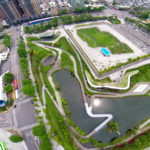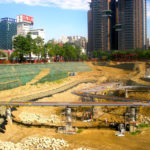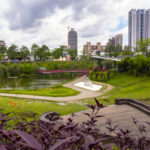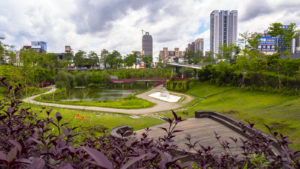
Efficient landscape engineering and effective geosynthetic materials built Maple Garden Park
In Taichung City, Taiwan, city dwellers wandering through Maple Garden Park are actually meandering below ground level. In November 2012, landscape engineers working with the aid of geosynthetic products converted a large hole in the heart of the city into an urban park oasis.
The area had originally been planned as the site of the Taichung International Expo Center, which was eventually built at another location. As a result, the abandoned site was a 30,000-square-meter excavated opening about 20 meters deep. When city planners sought to turn the site into a park, they knew they had to work within a short time frame and on a limited budget. And they envisioned an environmentally friendly multifunctional park constructed with limited use of concrete.
Applicable construction works for this submission included a continuous perimeter of walls and slopes, under ground level, reinforced with geogrids and geotextiles; an ecological detention pond with a volume of 200,000 cubic meters; and erosion control for the landscape.
The surrounding walls and slopes of the excavated opening were wrapped and reinforced with high-strength geogrids, geotextile soil bags, and vegetation mats. These formed the mechanically stabilized earth walls and slopes. They also incorporated turf reinforcement mats and gabions into the landscape to help vegetation grow and to control erosion.
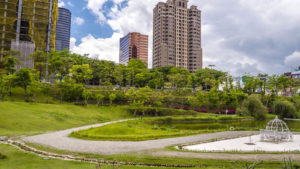 Geotextile bags, geomembranes, and gabions were used in the construction of a 200,000-cubic-meter ecological detention pond that connected to the city drainage system to regulate floodwaters.
Geotextile bags, geomembranes, and gabions were used in the construction of a 200,000-cubic-meter ecological detention pond that connected to the city drainage system to regulate floodwaters.
Taking a geosynthetic approach reduced the use of concrete and cut construction time and costs. The results gave residents quick access to a soothing, green oasis amid Taichung’s bustling streets.
To further enhance the atmosphere:
- a restaurant was built in front of the pond, merging with a reinforced wall.
- an exhibition center was built at the Taiwan Boulevard entrance.
- crushed aggregates, timbers, and wood chips were used in permeable pavements beside the pond.
 TEXTILES.ORG
TEXTILES.ORG



